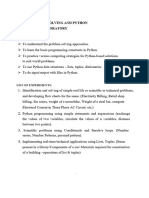Python Programs Google Docs
Uploaded by
Sundari YBTPython Programs Google Docs
Uploaded by
Sundari YBTlOMoARcPSD|20682595
Python programs - Google Docs
Python Programming laboratory (Anna University)
Studocu is not sponsored or endorsed by any college or university
Downloaded by Sundari YBT (sundari.ybt@hmgi.ac.in)
lOMoARcPSD|20682595
1.ELECTRICITY BILL
PROGRAM:
name=input("Enter Your Name:")
units=int(input("Enter Your Units:"))
if units==500:
charge=100+units*1.75
elif units>=300 and units<500:
charge=50+units*0.75
elif units>=200 and units<300:
charge=25+units*0.65
elif units>=100 and units<200:
charge=15+units*0.50
else:
charge=units*0.25
print("The Charge For Your Electric Bill Is:",charge)
Downloaded by Sundari YBT (sundari.ybt@hmgi.ac.in)
lOMoARcPSD|20682595
1.ELECTRICITY BILL
OUTPUT:
Result:
Thus the python program to get user's electric bill is executed successfully and the
Output is verified.
Downloaded by Sundari YBT (sundari.ybt@hmgi.ac.in)
lOMoARcPSD|20682595
2.SIN SERIES
PROGRAM:
x = int(input("Enter the value of x: "))
n = int(input("Enter the value of n: "))
sign = -1
fact = i =1
sum = 0
while i<=n:
p=1
fact = 1
for j in range(1,i+1):
p = p*x
fact = fact*j
sign = -1*sign
sum = sum + sign* p/fact
i = i+2
print("sin(",x,") =",sum)
Downloaded by Sundari YBT (sundari.ybt@hmgi.ac.in)
lOMoARcPSD|20682595
2.SIN SERIES
OUTPUT:
Result:
Thus the python program to compute sin series is executed successfully and the
Output is verified.
Downloaded by Sundari YBT (sundari.ybt@hmgi.ac.in)
lOMoARcPSD|20682595
3.WEIGHT OF A STEEL BAR
PROGRAM:
d=int(input("Enter a value of Diameter:"))
L=int(input("Enter a value of Length:"))
#calculate weight
weight=d*d*L/162
print('The Value of Weight:',weight)
Downloaded by Sundari YBT (sundari.ybt@hmgi.ac.in)
lOMoARcPSD|20682595
3.WEIGHT OF A STEEL BAR
OUTPUT:
Result:
Thus the python program to calculate weight of a steel bar is executed successfully
and the output is verified.
Downloaded by Sundari YBT (sundari.ybt@hmgi.ac.in)
lOMoARcPSD|20682595
4.ELECTRIC CURRENT IN A THREE PHASE AC CIRCUIT
PROGRAM:
import math
P = eval(input("Enter power (in Watts) : "))
pf = eval(input("Enter power factor (pf<1): "))
VL = eval(input("Enter Line Voltage (in Volts) : "))
CL = P/(math.sqrt(3)*VL*pf)
print("Line Current =", round(CL,2),"A")
Downloaded by Sundari YBT (sundari.ybt@hmgi.ac.in)
lOMoARcPSD|20682595
4.ELECTRIC CURRENT IN A THREE PHASE AC CIRCUIT
OUTPUT:
Result:
Thus the python program to compute electric current in a three phase AC
circuit is executed successfully and the output is verified.
Downloaded by Sundari YBT (sundari.ybt@hmgi.ac.in)
lOMoARcPSD|20682595
5.(a).EXCHANGE THE VALUES OF TWO VARIABLES USING THIRD
VARIABLE
PROGRAM:
x=input("Enter value of x: ")
y=input("Enter the value of y: ")
a=x
x=y
print("The value of x: ",x)
print ("The value of y: ",a)
Downloaded by Sundari YBT (sundari.ybt@hmgi.ac.in)
lOMoARcPSD|20682595
5.(a).EXCHANGE THE VALUES OF TWO VARIABLES USING THIRD
VARIABLE
OUTPUT:
Result:
Thus the python program to exchange the values of two variables using third
variable is executed successfully and the output is verified.
Downloaded by Sundari YBT (sundari.ybt@hmgi.ac.in)
lOMoARcPSD|20682595
5.(b).SWAP WITHOUT USING A THIRD VARIABLE
PROGRAM:
x=input("Enter value of x: ")
y=input("Enter the value of y: ")
(x, y)=(y, x)
print("The value of x: ",x)
print ("The value of y: ",y)
Downloaded by Sundari YBT (sundari.ybt@hmgi.ac.in)
lOMoARcPSD|20682595
5.(b).SWAP WITHOUT USING A THIRD VARIABLE
OUTPUT:
Result:
Thus the python program to swap without using a third variable is executed
successfully and the output is verified.
Downloaded by Sundari YBT (sundari.ybt@hmgi.ac.in)
lOMoARcPSD|20682595
6.(a).CIRCULATE THE VALUES OF N VARIABLES
PROGRAM:
# Circulate the values of n variables
n= int(input("Enter number of values : "))
#Read values
list1 = []
for val in range(0,n,1):
ele = int(input("Enter integer : "))
list1.append(ele)
#Circulate and display values
print("Circulating the elements of list ", list1)
for val in range(0,n,1):
ele = list1.pop(0)
list1.append(ele)
print(list1)
Downloaded by Sundari YBT (sundari.ybt@hmgi.ac.in)
lOMoARcPSD|20682595
6.(a).CIRCULATE THE VALUES OF N VARIABLES
OUTPUT:
Result:
Thus the python program to circulate the values of N variables is executed
successfully and the output is verified.
Downloaded by Sundari YBT (sundari.ybt@hmgi.ac.in)
lOMoARcPSD|20682595
6.(b).CALCULATE THE DISTANCE BETWEEN TWO ENDPOINTS
PROGRAM:
x1=float(input("Enter the x1 value: "))
y1=float(input("Enter the y1 value: "))
x2=float(input("Enter the x2 value: "))
y2=float(input("Enter the y2 value: "))
distance=((((x2-x1)**2)+((y2-y1)**2))**0.5)
print("The endpoints are : ","{:.3f}".format(distance))
Downloaded by Sundari YBT (sundari.ybt@hmgi.ac.in)
lOMoARcPSD|20682595
6.(b).CALCULATE THE DISTANCE BETWEEN TWO ENDPOINTS
OUTPUT:
Result:
Thus the python program to calculate the distance between two endpoints is executed
successfully and the output is verified.
Downloaded by Sundari YBT (sundari.ybt@hmgi.ac.in)
lOMoARcPSD|20682595
7.(a).FLOYD'S TRIANGLE
PROGRAM:
num=int(input("Enter the number of rows: "))
k=1
for i in range(1,num+1):
for j in range(1,i+1):
print(k,end=" ")
k=k+1
print()
Downloaded by Sundari YBT (sundari.ybt@hmgi.ac.in)
lOMoARcPSD|20682595
7.(a).FLOYD'S TRIANGLE
OUTPUT:
Result:
Thus the python program to print the floyd's triangle is executed
successfully and the output is verified.
Downloaded by Sundari YBT (sundari.ybt@hmgi.ac.in)
lOMoARcPSD|20682595
7.(b).PRINT PATTERN
PROGRAM:
num=int(input("Enter the number of rows: "))
k=1
for i in range(1,num+1):
for j in range(1,i+1):
print(j,end="")
k=k+1
print()
Downloaded by Sundari YBT (sundari.ybt@hmgi.ac.in)
lOMoARcPSD|20682595
7.(b).PRINT PATTERN
OUTPUT:
Result:
Thus the python program to print the given pattern is executed
successfully and the output is verified.
Downloaded by Sundari YBT (sundari.ybt@hmgi.ac.in)
lOMoARcPSD|20682595
7.(c).CALCULATE THE VALUE OF 13+23+33+…+N3
PROGRAM:
n = int(input(‘Enter a Number:’))
sum =0
i=1
while i<=n:
sum=sum+i*i*i
i+=1
print(‘sum=’,sum)
Downloaded by Sundari YBT (sundari.ybt@hmgi.ac.in)
lOMoARcPSD|20682595
7.(c).CALCULATE THE VALUE OF 13+23+33+…+N3
OUTPUT:
Result:
Thus the python program to calculate the value 1 +23+33+….+N3 is executed
3
successfully and the output is verified.
Downloaded by Sundari YBT (sundari.ybt@hmgi.ac.in)
lOMoARcPSD|20682595
8.(a).LIST OPERATIONS-CONSTRUCTION OF A BUILDING
PROGRAM:
#To append values in a list
l=[ ]
n=int(input("Enter no.of values to be inserted: "))
for i in range(n):
l.append(input("Enter the material required for construction of a building:") )
print("The created list is: ",l)
#To insert a value in a list using insert method
l.insert(0,'Steel Rod')
print("The list after inserting an new value is: ",l)
#To sort the list
l.sort()
print("The list after sorting is: ",l)
#To delete the value using pop
l.pop()
print("After deleting last value: ",l)
#To delete cement from the list
l.remove('cement')
print("After deleting the value: ",l)
Downloaded by Sundari YBT (sundari.ybt@hmgi.ac.in)
lOMoARcPSD|20682595
8.(a).LIST OPERATIONS-CONSTRUCTION OF A BUILDING
OUTPUT:
Result:
Thus the python program to demonstrate the various methods and operations
of list - Materials required for construction of a building is executed
successfully and the output is verified.
Downloaded by Sundari YBT (sundari.ybt@hmgi.ac.in)
lOMoARcPSD|20682595
8.(b).TUPLE ITEMS IN A LIBRARY
PROGRAM:
t=()
#To add the values in a tuple
n=int(input("Enter no.of values to be inserted: "))
for i in range(n):
t+=((input("Enter the items in Library: ")),)
print("The created tuple is: ",t)
#To find the length of the tuple
print("The length tuple is: ",len(t))
#To find the min and max value in a tuple
print("The minimum value in the tuple is: ",min(t))
print("The maximum value in the tuple is: ",max(t))
#To delete the tuple
del t
print("The tuple is deleted")
Downloaded by Sundari YBT (sundari.ybt@hmgi.ac.in)
lOMoARcPSD|20682595
8.(b).TUPLE ITEMS IN A LIBRARY
OUTPUT:
Result:
Thus the python program to demonstrate the various methods and operations
of a tuple item in the library is executed successfully and the output is verified.
Downloaded by Sundari YBT (sundari.ybt@hmgi.ac.in)
lOMoARcPSD|20682595
9.(a).SET METHODS AND OPERATIONS
PROGRAM:
#To create a set
l=[]
n=int(input("Enter no.of values to be inserted: "))
for i in range(n):
l.append(int(input("Enter a number: ")))
t=set(l)
print("The created set is: ",t)
#To find the length of the tuple
print("The length of set is: ",len(t))
#To find the min and max value in a tuple
print("The minimum value in the set is: ",min(t))
print("The maximum value in the set is: ",max(t))
#To print all the unique elements of list
print("The unique elements of the list are: ",list(t))
Downloaded by Sundari YBT (sundari.ybt@hmgi.ac.in)
lOMoARcPSD|20682595
9.(a).SET METHODS AND OPERATIONS
OUTPUT:
Result:
Thus the python program to demonstrate the various set methods and operations
Print all the unique elements of a list is executed successfully and the output
is verified.
Downloaded by Sundari YBT (sundari.ybt@hmgi.ac.in)
lOMoARcPSD|20682595
9.(b).DICTIONARY METHODS AND OPERATIONS-STUDENT
MARKSHEET
PROGRAM:
#To create a dictionary
d={}
n=int(input("Enter no.of values to be inserted: "))
for i in range(n):
a=input("Enter the subject: ")
b=int(input("Enter the mark: "))
d[a]=b
#To view key value pairs
print("The created dictionary is: ",d.items())
#To find the length of the dictionary
print("The length of the dictionary is: ",len(d))
#To delete the value using pop
d.pop(a)
print("After deleting last value: ",d)
#To delete entire dictionary
d.clear()
Downloaded by Sundari YBT (sundari.ybt@hmgi.ac.in)
lOMoARcPSD|20682595
9.(b).DICTIONARY METHODS AND OPERATIONS-STUDENT
MARKSHEET
OUTPUT:
Result:
Thus the python program to demonstrate the various methods and operations
Of a dictionary-student marksheet is executed successfully and the output
is verified.
Downloaded by Sundari YBT (sundari.ybt@hmgi.ac.in)
lOMoARcPSD|20682595
10.(a).FACTORIAL OF A GIVEN NUMBER
PROGRAM:
def factorial(num):
fact=1
i=1
while (i<=num):
fact=fact*i
i=i+1
return fact
num=int(input("Enter a number: "))
result=factorial(num)
print("factorial of the number:" ,result)
factorial(num)
Downloaded by Sundari YBT (sundari.ybt@hmgi.ac.in)
lOMoARcPSD|20682595
10.(a).FACTORIAL OF A GIVEN NUMBER
OUTPUT:
Result:
Thus the python program to find factorial of a given number using function
is executed successfully and the output is verified.
Downloaded by Sundari YBT (sundari.ybt@hmgi.ac.in)
lOMoARcPSD|20682595
10.(b).MAXIMUM AND MINIMUM NUMBER USING FUNCTION
PROGRAM:
def maxmin():
l=[]
a=int(input("Enter the number of elements: "))
for i in range(1,a+1):
num=int(input("Enter the values one by one: "))
l.append(num)
maximum = max(l)
minimum = min(l)
return maximum,minimum
output=maxmin()
print("The smallest value in the list is: ",output[1])
print("The largest value in the list is: ",output[0])
Downloaded by Sundari YBT (sundari.ybt@hmgi.ac.in)
lOMoARcPSD|20682595
10.(b).MAXIMUM AND MINIMUM NUMBER USING FUNCTION
OUTPUT:
Result:
Thus the python program to find maximum and minimum number from a given
list using function is executed successfully and the output is verified.
Downloaded by Sundari YBT (sundari.ybt@hmgi.ac.in)
lOMoARcPSD|20682595
11.(a).REVERSE A GIVEN STRING
PROGRAM:
a=input("Enter a string : ")
print("The reversed string will be: ",a[::-1])
Downloaded by Sundari YBT (sundari.ybt@hmgi.ac.in)
lOMoARcPSD|20682595
11.(a).REVERSE A GIVEN STRING
OUTPUT:
Result:
Thus the python program to reverse a given string is executed successfully
and the output is verified.
Downloaded by Sundari YBT (sundari.ybt@hmgi.ac.in)
lOMoARcPSD|20682595
11.(b).PALINDROME OR NOT
PROGRAM:
b=input("Enter a word to check it is palindrome or not: ")
if b==b[::-1]:
print(b,"- it is palindrome.")
else:
print(b,"- it is not palindrome")
Downloaded by Sundari YBT (sundari.ybt@hmgi.ac.in)
lOMoARcPSD|20682595
11.(b).PALINDROME OR NOT
OUTPUT:
Result:
Thus the python program to check whether the given string is palindrome or not
is executed successfully and the output is verified.
Downloaded by Sundari YBT (sundari.ybt@hmgi.ac.in)
lOMoARcPSD|20682595
11.(c).ANAGRAM OR NOT
PROGRAM:
a=input("Enter a string: ")
b=input("Enter a string: ")
if (sorted(a))==(sorted(b)):
print("Yes:) it is an anagram")
else:
print("No:( it is not anagram")
Downloaded by Sundari YBT (sundari.ybt@hmgi.ac.in)
lOMoARcPSD|20682595
11.(c).ANAGRAM OR NOT
OUTPUT:
Result:
Thus the python program to check whether the given string is anagram or not
is executed successfully and the output is verified.
Downloaded by Sundari YBT (sundari.ybt@hmgi.ac.in)
lOMoARcPSD|20682595
12.PROGRAM TO DEMONSTRATE PANDAS LIBRARY
Aim:
To understand about Working with Pandas dataframes
Installation of Pandas
If you have Python and PIP already installed on a system, then installation of
Pandas are very easy. It can be installed with this command
C:\Users\Your Name>pip install pandas
If this command fails, then use a python distribution that already has Pandas
installed like Anaconda, Spyder etc.
Importing Pandas
Once Pandas is installed, import it in your applications by adding the
import keyword:
import pandas as pd
Pandas DataFrame:
A Pandas DataFrame is a 2 dimensional data structure, like a 2 dimensional
array, or a table with rows and columns.
Locate Row:
Pandas uses the loc attribute to return one or more specified row(s)
#refer to the row index:
print(df.loc[0])
Locate Named Indexes
Use the named index in the loc attribute to return the specified row(s).
#refer to the named index:
print(df.loc["day2"])
Downloaded by Sundari YBT (sundari.ybt@hmgi.ac.in)
lOMoARcPSD|20682595
Load Files Into a DataFrame
import pandas as pd
df = pd.read_csv('data.csv')
print(df)
Using DataFrame method of Pandas:
1.
import pandas as pd
data = [1,2,3,4,5]
df = pd.DataFrame(data)
print(df)
OUTPUT
0
0 1
1 2
2 3
3 4
4 5
2.
import pandas as pd
data = [['Alex',10],['Bob',12],['Clarke',13]]
df = pd.DataFrame(data,columns=['Name','Age'])
print(df)
Name Age
0 Alex 10
1 Bob 12
2 Clarke 13
3.
import pandas as pd
data = {'Name':['Tom', 'Jack', 'Steve', 'Ricky'],'Age':[28,34,29,42]}
df = pd.DataFrame(data)
print(df)
OUTPUT
Name Age
0 Tom 28
1 Jack 34
2 Steve 29
3 Ricky 42
Downloaded by Sundari YBT (sundari.ybt@hmgi.ac.in)
lOMoARcPSD|20682595
4.
#Program to demonstrate missing values –NAN(Not A Number)
import pandas as pd
data = [{'a': 1, 'b': 2},{'a': 5, 'b': 10, 'c': 20}]
df = pd.DataFrame(data)
print(df)
OUTPUT
a b c
0 1 2 NaN
1 5 10 20.0
5.
import pandas as pd
data = [{'a': 1, 'b': 2},{'a': 5, 'b': 10, 'c': 20}]
#With two column indices, values same as dictionary keys
df1 = pd.DataFrame(data, index=['first', 'second'], columns=['a', 'b'])
#With two column indices with one index with other name
df2 = pd.DataFrame(data, index=['first', 'second'], columns=['a', 'b1'])
print(df1)
print(df2)
OUTPUT
a b
first 1 2
second 5 10
a b1
first 1 NaN
second 5 NaN
Pandas Series
A pandas Series is a one-dimensional labeled data structure which can
hold data such as strings, integers and even other Python objects.
It is built on top of a numpy array and is the primary data structure to hold
one-dimensional data in pandas.
6.
import pandas as pd
#Series
d = {'one' : pd.Series([1, 2, 3], index=['a', 'b', 'c']),
'two' : pd.Series([1, 2, 3, 4], index=['a', 'b', 'c', 'd'])}
Downloaded by Sundari YBT (sundari.ybt@hmgi.ac.in)
lOMoARcPSD|20682595
df = pd.DataFrame(d)
# Adding a new column to an existing DataFrame object with column label
by passing new series
print ("Adding a new column by passing as Series:")
df['three']=pd.Series([10,20,30],index=['a','b','c'])
print(df)
print ("Adding a new column using the existing columns in DataFrame:")
df['four']=df['one']+df['three']
print(df)
OUTPUT
Adding a new column by passing as Series:
one two three
a 1.0 1 10.0
b 2.0 2 20.0
c 3.0 3 30.0
d NaN 4 NaN
Adding a new column using the existing columns in DataFrame:
one two three four
a 1.0 1 10.0 11.0
b 2.0 2 20.0 22.0
c 3.0 3 30.0 33.0
d NaN 4 NaN NaN
7.
# Using the previous DataFrame, we will delete a column
# using del function
import pandas as pd
d = {'one' : pd.Series([1, 2, 3], index=['a', 'b', 'c']),
'two' : pd.Series([1, 2, 3, 4], index=['a', 'b', 'c', 'd']),
'three' : pd.Series([10,20,30], index=['a','b','c'])}
df = pd.DataFrame(d)
print ("Our data frame is:")
print df
# using del function
print ("Deleting the first column using DEL function:")
del df['one']
print(df)
Downloaded by Sundari YBT (sundari.ybt@hmgi.ac.in)
lOMoARcPSD|20682595
# using pop function
print ("Deleting another column using POP function:")
df.pop('two')
print(df)
8.
import pandas as pd
d = {'one' : pd.Series([1, 2, 3], index=['a', 'b', 'c']),
'two' : pd.Series([1, 2, 3, 4], index=['a', 'b', 'c', 'd'])}
df = pd.DataFrame(d)
print(df.loc['b'])
OUTPUT
one 2.0
two 2.0
Name: b, dtype: float64
9.
import pandas as pd
d = {'one' : pd.Series([1, 2, 3], index=['a', 'b', 'c']),
'two' : pd.Series([1, 2, 3, 4], index=['a', 'b', 'c', 'd'])}
df = pd.DataFrame(d)
print(df[2:4])
OUTPUT
one two
c 3.0 3
d NaN 4
10.
import pandas as pd
df = pd.DataFrame([[1, 2], [3, 4]], columns = ['a','b'])
df2 = pd.DataFrame([[5, 6], [7, 8]], columns = ['a','b'])
df = df.append(df2)
print(df)
Downloaded by Sundari YBT (sundari.ybt@hmgi.ac.in)
lOMoARcPSD|20682595
OUTPUT
a b
0 1 2
1 3 4
0 5 6
1 7 8
Result:
Thus working with Pandas DataFrames is completed.
Downloaded by Sundari YBT (sundari.ybt@hmgi.ac.in)
lOMoARcPSD|20682595
13.PROGRAM TO DEMONSTRATE NUMPY LIBRARY
Aim:
To understand about working with Numpy arrays
Numpy Arrays:
If you have Python and PIP already installed on a system, then installation
of NumPy is very easy.
Install it using this command:
Once NumPy is installed, import it in your applications by adding the import
keywords:
Numpy Arrays
NumPy is used to work with arrays. The array object in NumPy
is
called ndarray.
Importing and creating an array in numpy
OUTPUT:
[1 2 3 4 5]
[[1 2 3]
[4 5 6]]
[[[1 2 3]
[4 5 6]
[1 2 3]
[4 5 6]]]
Downloaded by Sundari YBT (sundari.ybt@hmgi.ac.in)
lOMoARcPSD|20682595
Finding the dimension of numpy array:
import numpy as np
a = np.array(42)
b = np.array([1, 2, 3, 4, 5])
print(a.ndim)
print(b.ndim)
OUTPUT:
0
3
Array indexing
Array indexing is the same as accessing an array element.
import numpy as np
#1D arrays
arr = np.array([1, 2, 3, 4])
print(arr[0])
#MultiDimensional Arrays
arr = np.array([[1,2,3,4,5], [6,7,8,9,10]])
print('5th element on 2nd row: ', arr[1, 4])
OUTPUT
1
5th element on 2nd row: 9
Array Slicing
Slicing in python means taking elements from one given index to another given
index. We pass a slice instead of an index like this: [start:end].
We can also define the step, like this: [start:end:step]
Downloaded by Sundari YBT (sundari.ybt@hmgi.ac.in)
lOMoARcPSD|20682595
import numpy as np
arr = np.array([1, 2, 3, 4, 5, 6, 7])
#prints from 2nd to 5th element
print(arr[1:5])
arr = np.array([[1, 2, 3, 4, 5], [6, 7, 8, 9, 10]])
#print 2nd to 4th element from the 2nd element
print(arr[1, 1:4])
OUTPUT
[7 8 9]
ARRAY SHAPE:
NumPy arrays have an attribute called shape that returns a tuple with each
index having the number of corresponding elements.
import numpy as np
arr = np.array([[1, 2, 3, 4], [5, 6, 7, 8]])
print(arr.shape)
OUTPUT
(2, 4)
Array Reshape
By reshaping we can add or remove dimensions or change the number of
elements in each dimension.
#Converting a 1d array to 2d
import numpy as np
arr = np.array([1, 2, 3, 4, 5, 6, 7, 8, 9, 10, 11, 12])
newark =arr.reshape(4, 3)
print(newarr)
OUTPUT
[[ 1 2 3]
[ 4 5 6]
[ 7 8 9]
[10 11 12]]
Downloaded by Sundari YBT (sundari.ybt@hmgi.ac.in)
lOMoARcPSD|20682595
Array Iteration
Iterating means going through elements one by one.
#iterating in a 1d array
import numpy as np
arr = np.array([1,2, 3])
for x in arr:
print(x)
OUTPUT
1
2
3
Array joining
Joining means putting contents of two or more arrays in a single array.
Array shape
import numpy as np
arr1 = np.array([1, 2, 3])
arr2 = np.array([4, 5, 6])
arr = np.concatenate((arr1, arr2))
print(arr)
OUTPUT
[1 2 3 4 5 6]
Splitting is the reverse operation of Joining. Splitting breaks one array into
Multiple.
import numpy as np
arr = np.array([1, 2, 3, 4, 5, 6])
newarr = np.array_split(arr, 3)
print(newarr)
Downloaded by Sundari YBT (sundari.ybt@hmgi.ac.in)
lOMoARcPSD|20682595
OUTPUT
[array([1, 2]), array([3, 4]), array([5, 6])]
Array Sorting
Sorting means putting elements in an ordered sequence.
import numpy as np
#sorting numbers in ascending order
arr = np.array([3, 2, 0, 1])
print(np.sort(arr))
#sorting in alphabetical order
arr = np.array(['banana', 'cherry', 'apple'])
print(np.sort(arr))
OUTPUT
['apple' 'banana' 'cherry']
Numpy Average
To find the average of an numpy array, you can use the numpy.average()
Function.
Syntax
numpy.average(a, axis=None, weights=None, returned=False)
Numpy Average
# Using numpy to calculate the average of a list
from numpy import mean
numbers = [1,2,3,4,5,6,7,8,9]
average = mean(numbers)
print(average)
Downloaded by Sundari YBT (sundari.ybt@hmgi.ac.in)
lOMoARcPSD|20682595
OUTPUT
5.0
Numpy Mean
The numpy mean function is used for computing the arithmetic mean of the
input values.
Syntax
numpy.mean(a, axis=some_value, dtype=some_value, out=some_value,
keepdims=some_value)
Example
from numpy import mean
number_list = [45, 34, 10, 36, 12, 6, 80]
avg = mean(number_list)
print("The average is ", round(avg,2))
OUTPUT
The average is 31.86
The numpy median function helps in finding the middle value of a sorted array.
Syntax
numpy.median(a, axis=None, out=None, overwrite_input=False,
keepdims=False)
Example
import numpy
speed = [99,86,87,88,86,103,87,94,78,77,85,86]
x = numpy.median(speed)
print(x)
Downloaded by Sundari YBT (sundari.ybt@hmgi.ac.in)
lOMoARcPSD|20682595
OUTPUT
86.5
Numpy Mode
The Mode value is the value that appears the most number
of times.
Syntax
scipy.stats.mode(a, axis=0, nan_policy='propagate')
Use the SciPy mode() method to find the number that appears the most.
Example
from scipy import stats
speed = [99,86,87,88,111,86,103,87,94,78,77,85,86]
x = stats.mode(speed)
print(x)
OUTPUT
ModeResult(mode=array([86]), count=array([3]))
RESULT
Thus working with Numpy is completed.
Downloaded by Sundari YBT (sundari.ybt@hmgi.ac.in)
lOMoARcPSD|20682595
14.PROGRAM TO DEMONSTRATE MATPLOTLIB LIBRARY
Aim:
To understand about basic plots using matplotlib
Matplotlib is a low level graph plotting library in python that serves as a
visualization utility.
Matplotlib is mostly written in python, a few segments are written in C, Objective-C
and Javascript for Platform compatibility.
Installation of Matplotlib
If you have Python and PIP already installed on a system, then installation of
Matplotlib is very easy.
Importing Matplotlib
Once Matplotlib is installed, import it in your applications by adding the import module
statement:
import matplotlib
Now Matplotlib is imported and ready to use:
Pyplot
Most of the Matplotlib utilities lies under the pyplot submodule, and are
usually imported under the plt alias:
import matplotlib.pyplot as plt
Now the Pyplot package can be referred to as plt.
Downloaded by Sundari YBT (sundari.ybt@hmgi.ac.in)
lOMoARcPSD|20682595
Draw a line in a diagram from position (0,0) to position (6,250):
Import matplotlib.pyplot
as plt import numpy as np
xpoints = np.array([0, 6])
ypoints = np.array([0, 250])
plt.plot(xpoints, ypoints)
plt.show()
OUTPUT
Matplotlib plotting:-
Plotting x and y points
The plot() function is used to draw points (markers) in a diagram. Draw a line
in a diagram from position (1, 3) to position (8, 10):
import matplotlib.pyplot as plt
import numpy as np
xpoints = np.array([1, 8])
ypoints = np.array([3, 10])
plt.plot(xpoints,ypoints)
plt.show()
Downloaded by Sundari YBT (sundari.ybt@hmgi.ac.in)
lOMoARcPSD|20682595
OUTPUT
Plotting Without Line
To plot only the markers, you can use the shortcut string notation parameter 'o',
which means 'rings'.
Draw two points in the diagram, one at position (1, 3) and one in position (8, 10):
import matplotlib.pyplot as plt
import numpy as np
xpoints = np.array([1, 8])
ypoints = np.array([3, 10])
plt.plot(xpoints, ypoints, 'o')
plt.show()
OUTPUT
Downloaded by Sundari YBT (sundari.ybt@hmgi.ac.in)
lOMoARcPSD|20682595
You can plot as many points as you like, just make sure you have the same
number of points in both axes.
Draw a line in a diagram from position (1, 3) to (2, 8) then to (6, 1) and
finally to position (8, 10):
import matplotlib.pyplot as plt
import numpy as np
xpoints = np.array([1, 2, 6, 8])
ypoints = np.array([3, 8, 1, 10])
plt.plot(xpoints, ypoints)
plt.show()
OUTPUT
Default X-Points
If we do not specify the points in the x-axis, they will get the default values
0, 1, 2, 3, (etc. depending on the length of the y-points.
So, if we take the same example as above, and leave out the x-points, the
diagram will look like this:
Plotting without x-points:
Downloaded by Sundari YBT (sundari.ybt@hmgi.ac.in)
lOMoARcPSD|20682595
import matplotlib.pyplot as plt
import numpy as np
ypoints = np.array([3, 8, 1, 10, 5, 7])
plt.plot(ypoints)
plt.show()
OUTPUT
Creating Scatter Plots
With Pyplot, you can use the scatter() function to draw a scatter plot.
The scatter() function plots one dot for each observation. It needs two arrays
of the same length, one for the values of the x-axis, and one for values on
the y-axis:
import matplotlib.pyplot as plt
import numpy as np
x = np.array([5,7,8,7,2,17,2,9,4,11,12,9,6])
y = np.array([99,86,87,88,111,86,103,87,94,78,77,85,86])
plt.scatter(x, y)
plt.show()
Downloaded by Sundari YBT (sundari.ybt@hmgi.ac.in)
lOMoARcPSD|20682595
OUTPUT
Result:
Thus working with matplotlib is completed.
Downloaded by Sundari YBT (sundari.ybt@hmgi.ac.in)
lOMoARcPSD|20682595
15.(a).COPYING CONTENT OF ONE FILE TO ANOTHER FILE
PROGRAM:
f=open(‘abm.txt’,’r’)
f1=open(‘aba.txt’,’w’)
for i in f :
f1.write(i)
f1.close()
f1=open(‘aba.txt’)
print(“copied data from other file is:” ,f1.read())
Downloaded by Sundari YBT (sundari.ybt@hmgi.ac.in)
lOMoARcPSD|20682595
15.(a).COPYING CONTENT OF ONE FILE TO ANOTHER FILE
OUTPUT:
Downloaded by Sundari YBT (sundari.ybt@hmgi.ac.in)
lOMoARcPSD|20682595
Result:
Thus the python program to copy the content of a file to another is
executed successfully and the output is verified.
Downloaded by Sundari YBT (sundari.ybt@hmgi.ac.in)
lOMoARcPSD|20682595
15.(b).LONGEST WORD FROM A GIVEN FILE
PROGRAM:
#write a python program to find longest word in a file
with open ("sam.txt","r")as f:
words=f.read().split()
count=0
for word in words:
count+=1
print("The count of the word are: ",count)
print("The longest word is: ",max(words))
Downloaded by Sundari YBT (sundari.ybt@hmgi.ac.in)
lOMoARcPSD|20682595
OUTPUT:
Downloaded by Sundari YBT (sundari.ybt@hmgi.ac.in)
lOMoARcPSD|20682595
Result:
Thus the python program to find the longest word from a given file is
executed successfully and the output is verified.
Downloaded by Sundari YBT (sundari.ybt@hmgi.ac.in)
lOMoARcPSD|20682595
15.(c).OCCURRENCES OF A GIVEN WORD IN A GIVEN FILE
PROGRAM:
#write a python program to find the occurrences of a given word in a file
n=input("Enter a word: ")
with open ("sam.txt","r")as f:
words=f.read().split()
count=0
for word in words:
if word==n:
count+=1
print("The count of a given word is: ",count)
Downloaded by Sundari YBT (sundari.ybt@hmgi.ac.in)
lOMoARcPSD|20682595
15.(c).OCCURRENCES OF A GIVEN WORD IN A GIVEN FILE
OUTPUT:
Result:
Thus the python program to find the occurrences of a given word in a given file is
executed successfully and the output is verified.
Downloaded by Sundari YBT (sundari.ybt@hmgi.ac.in)
lOMoARcPSD|20682595
16.(a).EXCEPTION HANDLING-DIVIDE BY ZERO ERROR
PROGRAM
try:
num1=int(input("Enter First Number:"))
num2=int(input("Enter Second Number:"))
result=num1/num2
print(result)
except ValueError as e:
print("Invalid Input Integer")
except ZeroDivisionError as e:
print(e)
Downloaded by Sundari YBT (sundari.ybt@hmgi.ac.in)
lOMoARcPSD|20682595
16.(a).EXCEPTION HANDLING-DIVIDE BY ZERO ERROR
OUTPUT:
RESULT
Thus the python program to find the minimum & maximum number in
a given list is executed successfully and the output is verified.
Downloaded by Sundari YBT (sundari.ybt@hmgi.ac.in)
lOMoARcPSD|20682595
16.(b).VOTERS AGE VALIDATION
PROGRAM
try:
age=int(input("enter the age of voter:"))
if age>=18:
print("Eligible to vote")
else:
print("Not eligible to vote")
except ValueError:
print("age must be a valid number")
Downloaded by Sundari YBT (sundari.ybt@hmgi.ac.in)
lOMoARcPSD|20682595
16.(b).VOTERS AGE VALIDATION
OUTPUT:
RESULT
Thus the python program to validate voter’s Age Using exception handling is
executed successfully and the output is verified.
Downloaded by Sundari YBT (sundari.ybt@hmgi.ac.in)
lOMoARcPSD|20682595
17.(a). DRAWING DIFFERENT SHAPES-PYGAME
PROGRAM:
#python program to draw different shapes using pygame module
import pygame
pygame.init()
white=(255,255,255)
green=(0,255,0)
blue=(0,0,255)
black=(0,0,0)
red=(255,0,0)
x=400
y=400
display_surface=pygame.display.set_mode((x,y))
pygame.display.set_caption('Drawing')
display_surface.fill(white)
pygame.draw.circle(display_surface,green,(50,50),10,0)
pygame.draw.ellipse(display_surface,green,(300,250,40,80),1)
pygame.draw.rect(display_surface,black,(150,300,100,50))
while True:
for event in pygame.event.get():
if event.type==pygame.QUIT:
pygame.quit()
quit()
pygame.display.update()
Downloaded by Sundari YBT (sundari.ybt@hmgi.ac.in)
lOMoARcPSD|20682595
OUTPUT:
Downloaded by Sundari YBT (sundari.ybt@hmgi.ac.in)
lOMoARcPSD|20682595
RESULT
Thus the python pygame program to draw different shapes such as
circle,ellipse,rectangle is executed successfully and the output is verified.
Downloaded by Sundari YBT (sundari.ybt@hmgi.ac.in)
lOMoARcPSD|20682595
17.(b).SIMULATE A BOUNCING BALL-PYGAME
PROGRAM:
#Simulate a bouncing ball-Pygame
import pygame,sys,time,random
from pygame.locals import*
from time import*
pygame.init()
screen=pygame.display.set_mode((500,400),0,32)
pygame.display.set_caption("Bouncing Ball")
WHITE=(255,255,255)
RED=(255,0,0)
info=pygame.display.Info()
sw=info.current_w
sh=info.current_h
y=0
#Initial direction is down
direction=1
Downloaded by Sundari YBT (sundari.ybt@hmgi.ac.in)
lOMoARcPSD|20682595
while True:
screen.fill(WHITE)
pygame.draw.circle(screen,RED,(200,y),13,0)
sleep(.006)
y+=direction
if y>=sh:
#changes the direction from down to try:
direction=-1
elif y<=0:
#change the direction from up to down:
direction=1
pygame.display.update()
for event in pygame.event.get():
if event.type==QUIT:
pygame.quit()
sys.exit()
Downloaded by Sundari YBT (sundari.ybt@hmgi.ac.in)
lOMoARcPSD|20682595
17.(b).SIMULATE A BOUNCING BALL-PYGAME
OUTPUT:
Downloaded by Sundari YBT (sundari.ybt@hmgi.ac.in)
lOMoARcPSD|20682595
RESULT
Thus the python pygame program to simulate a bouncing ball is executed
successfully and the output is verified.
Downloaded by Sundari YBT (sundari.ybt@hmgi.ac.in)
lOMoARcPSD|20682595
Downloaded by Sundari YBT (sundari.ybt@hmgi.ac.in)
You might also like
- GE3171_Problem-Solving-and-Python-Programming-LabNo ratings yetGE3171_Problem-Solving-and-Python-Programming-Lab43 pages
- GE3171 Problem Solving and Python Programming Lab Manual ShanenNo ratings yetGE3171 Problem Solving and Python Programming Lab Manual Shanen44 pages
- GE3171 - PSPP Lab Manual Regulation 2021No ratings yetGE3171 - PSPP Lab Manual Regulation 202160 pages
- Problem Solving and PythonProgramming RECORDNo ratings yetProblem Solving and PythonProgramming RECORD41 pages
- GE3171 - Python Lab Manual ORIGINAL-convertedNo ratings yetGE3171 - Python Lab Manual ORIGINAL-converted93 pages
- Python Laboratory Manual (Single Sided)No ratings yetPython Laboratory Manual (Single Sided)41 pages
- Working With Images: Student Name Student Roll # Program SectionNo ratings yetWorking With Images: Student Name Student Roll # Program Section10 pages
- Matplotlib - Simple Plot - TutorialspointNo ratings yetMatplotlib - Simple Plot - Tutorialspoint4 pages
- "Creating Bar Chart by Using Matplotlib in Python": Case Study Report On100% (1)"Creating Bar Chart by Using Matplotlib in Python": Case Study Report On5 pages
- Pixel to Plate Generating Recipes from Food Images Using CNNNo ratings yetPixel to Plate Generating Recipes from Food Images Using CNN53 pages
- Downloadable: Cheat Sheets For AI, Neural Networks, Machine Learning, Deep Learning & Data Science PDFNo ratings yetDownloadable: Cheat Sheets For AI, Neural Networks, Machine Learning, Deep Learning & Data Science PDF34 pages
- Novel Covid-19 Dataset Analysis: A Project Report100% (3)Novel Covid-19 Dataset Analysis: A Project Report68 pages
- Module IV Data Visualization Using Python v2.6No ratings yetModule IV Data Visualization Using Python v2.621 pages
- Python Data Visualization Cookbook 2nd Edition Igor Milovanovic - Own the ebook now with all fully detailed content100% (1)Python Data Visualization Cookbook 2nd Edition Igor Milovanovic - Own the ebook now with all fully detailed content62 pages
- ENG 202: Computers and Engineering Object Oriented Programming in PYTHONNo ratings yetENG 202: Computers and Engineering Object Oriented Programming in PYTHON56 pages
- Interactive Applications Using Matplotlib - Sample Chapter100% (1)Interactive Applications Using Matplotlib - Sample Chapter24 pages
- Camera Vision Based Animal Beat Back System For Agriculture Using Machine LearningNo ratings yetCamera Vision Based Animal Beat Back System For Agriculture Using Machine Learning9 pages
- Complete Download Python Data Visualization Cookbook Milovanović PDF All Chapters100% (10)Complete Download Python Data Visualization Cookbook Milovanović PDF All Chapters70 pages
- Plotting With Pyplot: This PDF Is Created atNo ratings yetPlotting With Pyplot: This PDF Is Created at5 pages
- Cheat Sheets For AI, Neural Networks, Machine Learning, Deep Learning & Big Data PDF100% (1)Cheat Sheets For AI, Neural Networks, Machine Learning, Deep Learning & Big Data PDF30 pages
- Python Numpy Tutorial (CS231n-Stanford)No ratings yetPython Numpy Tutorial (CS231n-Stanford)27 pages
- Data Visualizations in Python With Matplotlib: Sidita Duli, PHDNo ratings yetData Visualizations in Python With Matplotlib: Sidita Duli, PHD6 pages

























































































